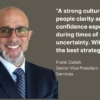
I realize that this statement and topic may strike a nerve, it certainly did with me. I was talking with a client the other day, and in recounting a recent conversation he had with his boss, it occurred to me that he wasn’t completely telling me the truth. Now as an executive coach, this is not the first time I’ve been ‘lied to’. I am frequently in the position of helping clients face various challenges, and skirting the truth appears frequently as individuals work through change. However, what struck me in this conversation is how used to being lied to I am. It doesn’t stand out to me anymore.
In looking at research on lying, I realized why I am so used to it! It is because everyone does it, and very frequently! University of Massachusetts psychologist Robert Feldman has studied lying for more than a decade, and his research found that 60% of people lie during a typical 10-minute conversation and that they average two to three lies during that short timeframe.
This statistic really stopped me in my tracks and had me rethink some of the other conversations I had earlier in the day. What was true and what wasn’t true? How much did it matter that I know the difference?
In reflection, I realized that many of my conversations contained exaggerations or white lies. For example, I may hear a colleague say “That’s my first priority” or “I only have 10 minutes because I have another call at…”. In my most recent client conversation, in hindsight, I don’t think the person even realized he/she wasn’t totally truthful. This unaware fibbing was addressed in Feldman’s study. In fact, most of the people in the study didn’t even realize all of the lies they have told until after the conversation when it was played back to them on video.
Feldman also found that women and men tend to lie for different reasons. “Women were more likely to lie to make the person they were talking to feel good, while men lied most often to make themselves look better,” Feldman said.
What are the implications of Feldman’s study for leaders?
Encourage and build a dynamic that strives for and rewards authenticity. An authentic workplace is a space where employees are encouraged to bring their whole selves to work every day, make deep connections, and feel inspired to do their best work as a result. Leaders in authentic workplaces value their employees as individuals
Make sure you are not a leader that can’t hear bad news
In a past life, I had a boss who was horrible at hearing bad news. He would immediately interrupt and fire off 2-3 actions (that in most cases were already attempted) and the staff left feeling berated and incompetent. Self-preservation encouraged the team to approach the boss very differently, and we all missed out on the learning that can come from transparency.
When mistakes happen, and they will, treat those mistakes as learning opportunities.
Embrace the innovation that was behind a failed attempt. At the end of the day, you want your people to feel empowered and they can’t feel that if they don’t take some chances.
What else can leaders do to encourage authenticity and transparency on their teams?
About MCG Partners
MCG Partners is a leadership and talent optimization firm aligning your business and people strategy for maximum results. MCG Partners is also a Predictive Index® (PI®) certified partner.
To learn more about MCG Partners’ services or The Predictive Index®, contact Cheryl Jacobs at cheryl.jacobs@mcgpartners.com or visit mcgpartners.com.






